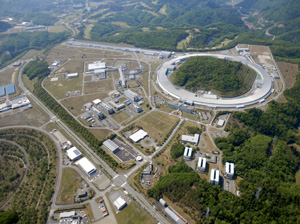Aug. 21, 2015 RIKEN Places Physics / Astronomy
Energizing photons to the max
The RIKEN SPring-8 Center hosts the most powerful synchrotron radiation facility in the world and an x-ray free-electron laser that is a billion times brighter.
The RIKEN SPring-8 Center hosts the most powerful synchrotron radiation facility in the world and an x-ray free-electron laser that is a billion times brighter
Encircling mount Miharakuriyama, about 100 kilometers west of Osaka, is a 1,436-meter-long obstacle course for subatomic athletes. Here, in the SPring-8 synchrotron facility at the RIKEN SPring-8 Center, bunches of electrons wiggle, lurch and careen through vacuums and magnetic fields at 200,000 loops a second. They whiz past, like Sonic the Hedgehog, in a flattened mass of ten billion electrons, three hairbreadths wide and nearly half a centimeter long. Just next door is the SPring-8 Angstrom Compact free electron LAser (SACLA), where particles ricochet like speeding bullets through a hundred-meter barrel of magnets in femtosecond rounds.
These electrons are accelerated to nearly the speed of light to produce some of the brightest electromagnetic radiation or light in the world, especially in the x-ray region. Researchers of all types use them to image objects even smaller in size than an atom.

Custom beamlines
Precision is critical at the RIKEN SPring-8 Center. The synchrotron storage ring consists of a chain of 1,500 massive magnets. To prevent the accelerator from expanding and contracting with changes in temperature, it is housed in a frame decoupled from its outer building. And the building itself has been carved into the bedrock to prevent the gravitational pulls of the Sun and Moon, which deform the Earth’s surface, from altering the length of the racetrack. Monitors installed at 300 locations along the rim detect any micrometer-long deviations that may develop over the course of a day.
Scientists and engineers at SPring-8 have constructed 57 beamlines that extract synchrotron radiation from SPring-8, and three beamlines at SACLA that produce coherent x-ray laser beams. The beams have been customized to suit the needs of research fields including biology, chemistry, photonics, quantum dynamics, magnetic materials and the physics of systems under extreme temperatures and pressures. Almost half of the beamlines at SPring-8 are publically accessible to researchers from any institution and a fifth are used by industry.
Lighting the way
 Figure 1: The SPring-8 Angstrom Compact free electron LAser is only walking distance away from the SPring-8 Center’s synchrotron radiation storage ring. © 2015 RIKEN
Figure 1: The SPring-8 Angstrom Compact free electron LAser is only walking distance away from the SPring-8 Center’s synchrotron radiation storage ring. © 2015 RIKEN
These facilities have yielded illuminating results, with about 800 papers based on experiments conducted at SPring-8 published annually. In 2015, for example, RIKEN researchers observed a polymer-based solar cell under synchrotron radiation to discover the secret of its high power conversion efficiency. And in 2014, among other discoveries at SACLA, researchers revealed the internal structure of living Microbacterium lacticum cells sealed in a liquid solution between two synthetic membranes. The laser beam was directed at a micrometer-sized spot, and snapshots of the cells were taken just femtoseconds before they died of radiation damage.
Highlighting the benefits of synchrotron radiation is another important aspect of the center’s work. For example, for the past eight years, RIKEN has been hosting the Cheiron School, which informs graduate students, postdoctoral researchers and young engineers in the Asia-Pacific region about useful techniques and applications. Over 60 participants are expected to participate in the next session in September 2015 and afterwards spread the knowledge of a powerful means to see the world.
